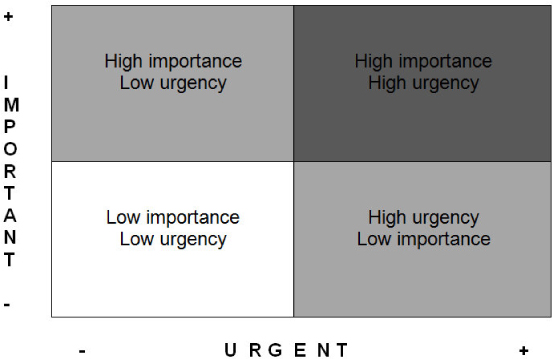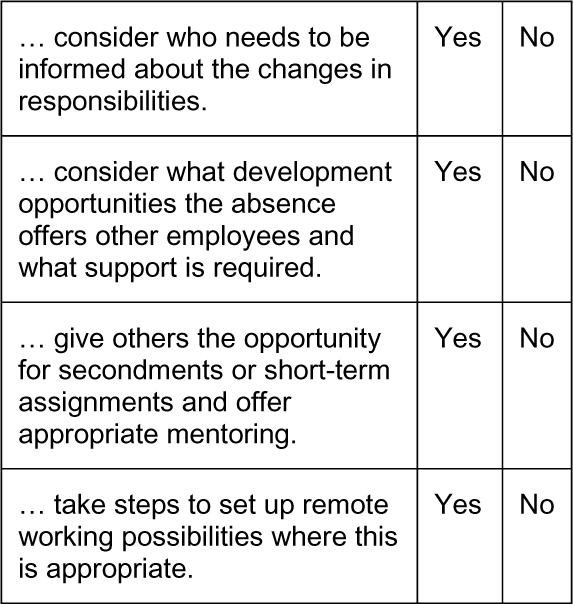CHAPTER 3: COVERING THE WORK OF
OTHERS IN THEIR ABSENCE
In order to minimise cost and disruption, it is likely that if an employee is absent, you will need to involve other people in covering their work. In this chapter, tips and techniques are provided for prioritising and delegating the workload, so that you can ensure a continuity of service.
Establishing priorities
Where possible, the first step in covering the workload of people who have unplanned absence is to make yourself aware of the work commitments that are outstanding. Look at their work calendar and also anticipate the future activities that will need to be covered in their absence.
Make sure that you prioritise what needs to be done in the person’s absence and what tasks can potentially wait until their return. Distinguish between important and urgent tasks. Consider:
• Urgency in relation to time: does this task need to be completed in the short term, or can it wait until the person’s return?
• Importance in relation to organisational need: is this a business critical activity?
Use a coding system to set the order of priority e.g.
• Tasks that are urgent and important: you will need to ensure that these tasks are given priority and are accomplished in the employee’s absence.
• Important but not urgent tasks: consider whether these tasks can wait until the employee returns. What are the implications of waiting to begin these activities? What are the deadlines? Can other members of the team begin the work?
• Not important but urgent tasks: these tasks do not necessarily take much time to achieve but have forthcoming deadlines. They potentially can be quickly slotted into other team members’ workloads.
• Not important and not urgent tasks: these can be left for when the employee returns.
Figure 1: Urgency and importance

If resources are tight, it is best, therefore, to focus on the critical activities that are important and urgent and to plan how to share these out across the team, rather than attempting to take on the whole of the employee’s workload.
A caveat here is that priorities can change by the day. Do ensure that (with their prior permission) you regularly monitor the absent employee’s e-mails and work requests, and that you reappraise the workload daily.
Planning the work
You have now established the objectives for the work that needs to be accomplished in the employee’s absence. Now you can use the OATS principle to help plan what needs to be done:
• Make sure you are clear what the key Objectives are that need to be achieved in the employee’s absence (the tasks that are important and urgent).
• Discuss with the team what Activities need to happen to achieve the objectives.
• Discuss what Time each person has available to complete the tasks, given their other priorities.
• Agree as a team how best to Schedule the activities, taking into account other people’s workloads.
A tip is to ensure you involve other members of the team in planning how the workload can be scheduled. You will need to have a clear understanding of the work stack of all of your team in order to do this. Look at the priorities for the whole team and see where there are areas that can give. Again, you can use the importance and urgency matrix to help you prioritise the tasks the team need to achieve as a whole.
Sharing and delegating tasks
Consider the best person in the team to take on the task in the light of their other commitments? Have they the skills and the confidence to do this? Is this a development opportunity for them, in which case what support do they need?
Remember when delegating and sharing the tasks that by involving the team member in how the task should be done, you gain greater buy-in and commitment.
Be clear on deadlines and responsibilities and how you will monitor the achievement of the task. Consider who else you need to tell about the change of responsibility and what other people you need to involve. It is a good idea to hold a team meeting to communicate the priorities and new responsibilities to the whole team, so that everyone is aware what needs to be done.
Secondments and mentoring
When one of your team is unexpectedly absent, this can provide a great opportunity for another team member to step up to the mark. They will then gain the experience and exposure that the other person’s role brings.
Consider who may benefit from a short-term secondment, a one-off assignment or expansion of their role. For example, when airports were closed and travellers stranded abroad, one IT Director was unable to travel to the UK from South Africa. He had an important presentation to make to the Board, but was unable to travel back in time to attend.
He selected one of his middle managers who had been working on the project to take his place. Via telephone coaching and mentoring he was able to help the individual to prepare and present the paper to the Board. The individual gained sign off to the project and also valuable exposure, confidence and skills in working at a senior level.
If you do decide to second someone to take on the role of the absent employee, make sure that you provide clear direction, encouragement and support. Let others know that the person is taking on the role, what their responsibilities will be and for how long.
Remote working and its implications
A further option to consider, dependent on the circumstance, is the provision of home or remote working. If the individual is willing and technology allows, they may be able to work from home or from the location in which they find themselves.
Make sure that you discuss this thoroughly with the team member. Remote working requires a great degree of trust and cooperation by both parties. Providing relevant technological support, such as a mobile phone, BlackBerry, iPhone, or laptop and remote access is important. Be aware also of security issues when sending data remotely. It may be worth considering an encryption option for confidential data.
Above all, keep in regular contact with the team member and allow some flexibility in the situation. If someone is absent because of weather or travel conditions, they may well need to check with airlines or travel companies about their arrangements. It is unrealistic to expect people in these circumstances to produce the same level of outputs as in a normal office situation.
Table 4: Rate how well you manage the cover of an absent employee’s workload
When an employee is unexpectedly absent I:


